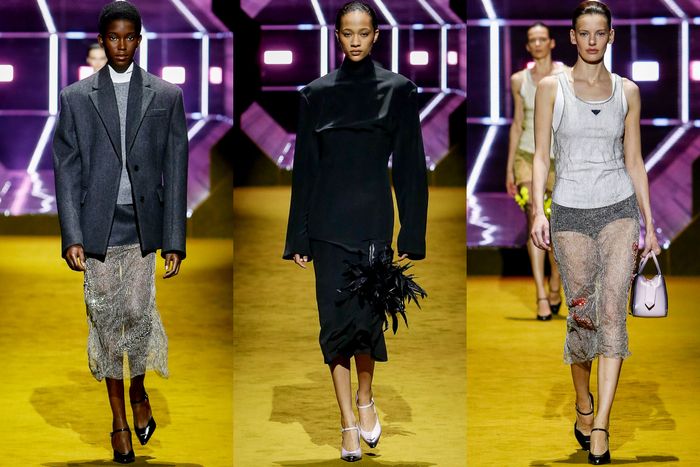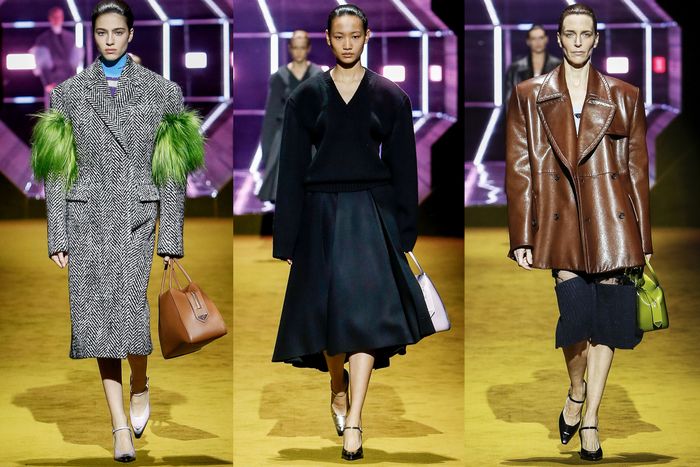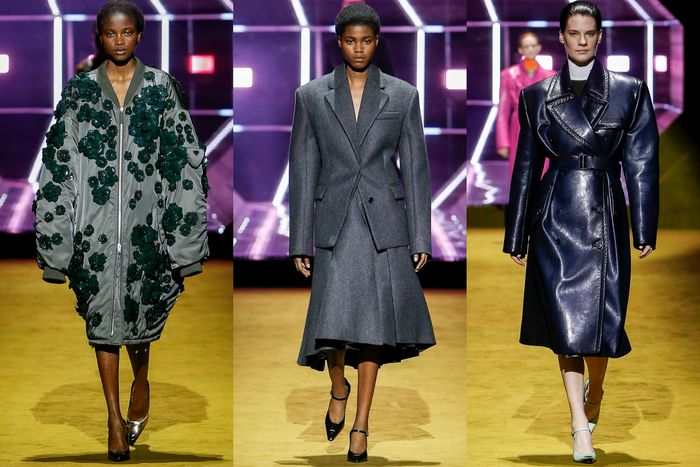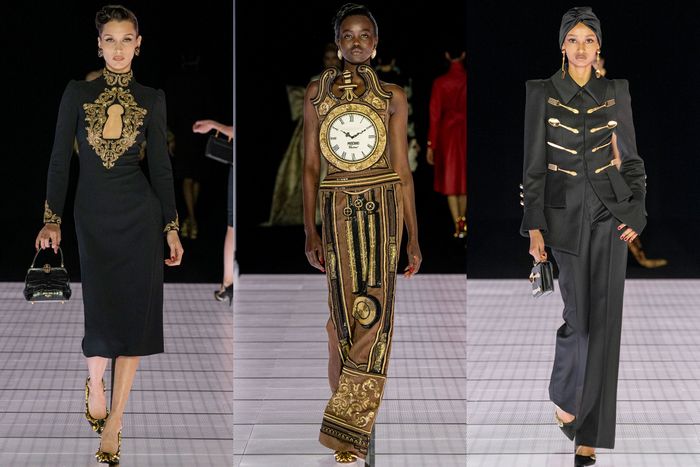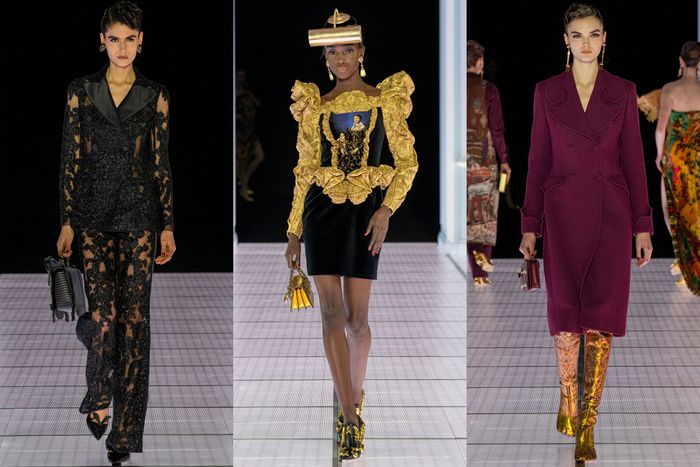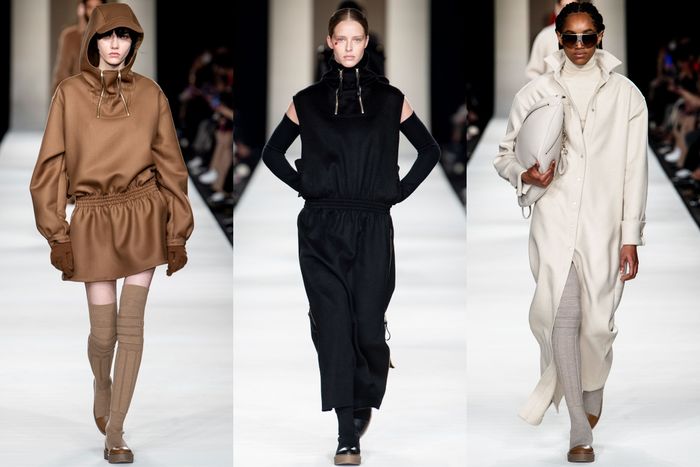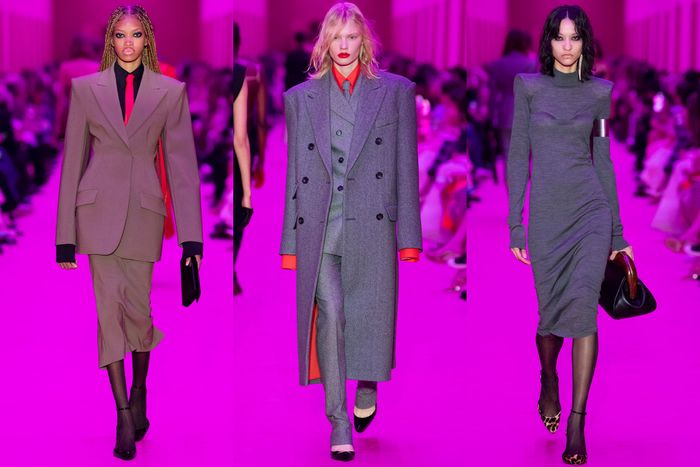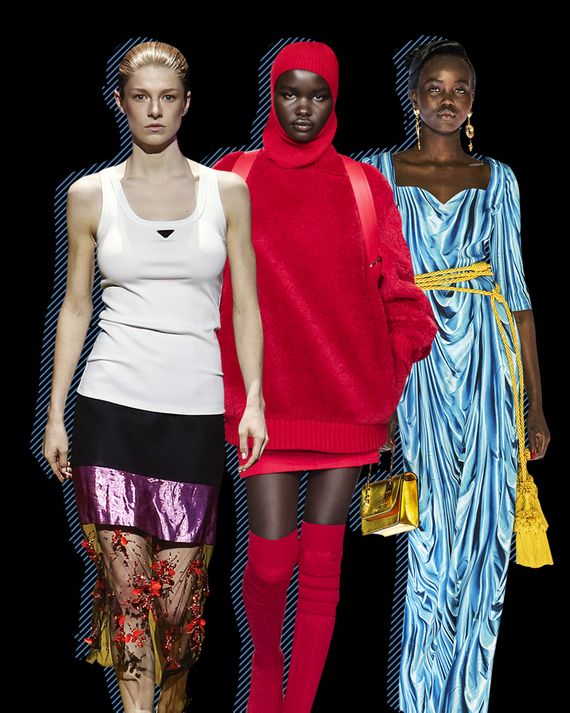
Miuccia Prada and Raf Simons are two of the greatest talkers in fashion, unpacking its history, parsing the news, and discussing their feelings, and the result is a Prada that feels profoundly new. Some collections might strike people as “more Raf than Miuccia” — to which Miuccia would probably reply, “Well, if Raf has something more interesting to say …” She doesn’t have those kinds of barriers, in other words. As it happens, the latest collection is pure Miuccia, with elements of Raf woven into the Prada story.
What is central to that story are her views on women — a smart, grown-up individual who didn’t appear to really like fashion. You can see Prada’s first fashion show, from 1988, on YouTube. Held in a series of elegant rooms, a waiter was still serving drinks to guests as the models casually began to walk. Not only were some of them older, but they wore styles that in time became Prada signatures — the plain V-neck sweater, the full skirt. And this was during a period when Gianni Versace, Thierry Mugler, and Jean Paul Gaultier were burning up the runways with sex bombs.
On Thursday afternoon, in the vast presentation space of the Fondazione Prada, some of the girls were again older — Hannelore Knuts, Liya Kebede, and the English beauty Erin O’Connor. They walked with newer models like Kaia Gerber and Hunter Schafer, the Euphoria star, who wore a white ribbed undershirt with a skirt that consisted of a black panel, another in crushed fuchsia silk, and then a transparent section in black tulle embroidered with red satin bits. Schafer had on no jewelry, carried no bag, and like all the models, wore a wedge-heel pump with a strap.
But the models were not the only connection to Prada’s stylistic origins. Midway through the show there were suits with full skirts, now made fuller and with more movement, and a V-neck sweater with one of the skirts. Those jackets, along with double-breasted wool coats — some in solid wool, others in tweed — were slightly oversized in the shoulders, sculpted at the waist (a view best seen from the back), and very, very elegant. They, too, are part of the Prada story, although the cut and proportions (and adornment) kept changing with the years. And, of course, Prada’s moods.
At the 1988 show, guests sat on spindly chairs. Last September, the set was an elaborate grid of wood boxes interspersed with video monitors, and the models walked among the guests. Yesterday, Simons and Prada, as if seeking a clean slate, used long rows of movie-theater seating, with the models emerging from a futuristic-looking tunnel and then crossing a plain and wide carpeted space before exiting through another tunnel at the opposite corner of the room. Depeche Mode played throughout.
Schafer’s sheer outfit, with its garish bit of fuchsia, also harked back to another Prada concept, perhaps the hardest in her repertoire to put your finger on. I remember watching Prada collections in the late ’90s and early 2000s when she would show, basically, a filmy slip and a pair of underpants, or underpants with, say, a polo knit. At the time, the sexual expression was as unique as it was confounding. For me, those slips conjured so many images, though mainly of Germany in the 1930s. Prada’s references were—are—vast and personal.
That frisson of sexuality, which is more womanly than girlish, ran through Thursday’s show, I’m delighted to say, and it took a number of forms, including a pair of belted coats in thick yet softened hot pink or black leather (they are so chic yet dirty in mood that who needs to wear anything under them except a slip?) and a group of a long-sleeve black silk dresses, quite austere except for a lick of feathers at the neckline or, say, the hip.
One can imagine that Simons would be intrigued by the hallmarks of Prada’s style, though perhaps Miuccia herself might be more neutral, having created them. But given the storm of images that is a defining characteristic (so far) of the 21st century, it’s important for the Prada brand to sharpen people’s attention on its identity. This was no nostalgia trip. And, as Miuccia would surely expect of their partnership, Simons moves the label forward with tastes of his own. Has Prada ever done a blouson jacket? Possibly, but here was a favorite Simons style melded into the Prada tradition, now in Prada nylon, slightly oversized, and sometimes even embroidered with shimmery, sick-green flowers.
The Milan shows have been remarkably good. On a grim news day, Moschino’s Jeremy Scott performed an essential function of fashion: to be outrageous, to mock its own illusions. The set was a fancy room in a fancy European house, and the models’ clothes were swagged in rich fabric (possibly the curtains), or shaped like a grandfather clock or a Coromandel screen, or adorned in gold trim. A hat could be a fringed lampshade or — why not?—a pair of cuckoo clocks. Yet skim off the jokes, and the clothes were elegant and varied, with beautiful coats and suits, including a reprise of Franco Moschino’s “dinner suit,” with cutlery trimming the front of the jacket, and a drop-dead evening pantsuit in black lace. Scott had the last laugh, coming out in a red astronaut suit—apparently a nod to the 1968 movie, 2001: A Space Odyssey.
Max Mara and its offbeat sister label, Sportmax, were also committed to making big fashion statements. The exuberant radicalism of the Swiss-born artist and designer Sophie Taeuber-Arp (1889–1943) was the starting point for Max Mara’s strong silhouettes, many using the brand’s famous “teddy bear” fabric—for bell-shaped skirts, full-cut trousers, and shorts. If that sounds crazy, that’s the point: It was playful, risk-taking fashion. The collection was loaded with interesting pieces in a concise palette of warm browns, cream, black, and red, including teddy-bear tunics; military coats; a fabulous sleeveless and ankle-length tunic in black wool with a dropped waist; and crepe-soled, fully knitted, over-the-knee boots (with zips up the back). Another difference this season is that Tonne Goodman styled the show for the first time, adding to its visual sharpness.
I don’t know why Sportmax has “sport” in it, because it doesn’t seem so sporty these days — and I’m glad. It has almost become Max Mara’s weird, experimental relation, though still in the luxury vein. Staged this season in a long room bathed in hot pink, the key motifs were retro-futurism (think Blade Runner) and good old Helmut Newton kinky glamour. Suitably, the tailoring was frighteningly feminine, verging on the shapes developed by Demna at Balenciaga, while several of the evening looks — worth a look if you’re shopping this fall — have cutouts that follow the contours of the body. Again, the departing glance is the clincher.
More From Milan Fashion Week
- The Best Street Style at Milan Fashion Week
- Bottega Veneta’s Strong Debut
- Gucci’s Sharp Tailoring With an Agile Street Edge



